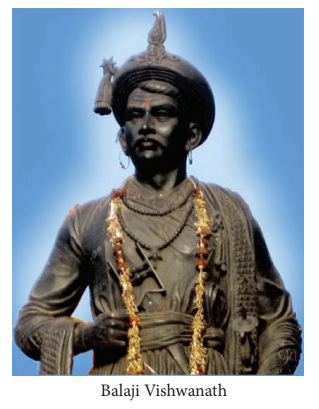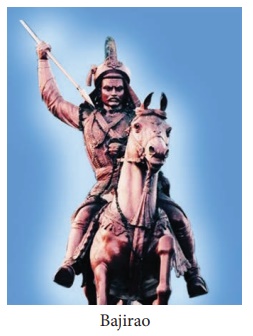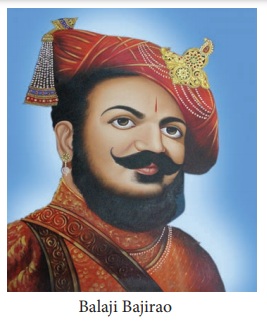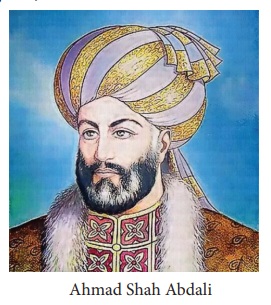Term 2 Unit 3 | History | 7th Social Science - Rise of Peshwas | 7th Social Science : History : Term 2 Unit 3 : Rise of Marathas and Peshwas
Chapter: 7th Social Science : History : Term 2 Unit 3 : Rise of Marathas and Peshwas
Rise of Peshwas
Rise of Peshwas
Peshwas
Balaji Vishwanath (1713–1720) began his
career as a small revenue official and became Peshwa in 1713. Much against the advice
from his close circles, Shahu appointed 20-year-old Viswanath’s eldest son Bajirao
to occupy the office of Peshwa.

Bajirao (1720–1740)
Bajirao decided to launch a major Maratha onslaught against the Mughals and the Nizam of Hyderabad. He assumed the powers of the commander-in-chief. He was wise in his choice of commanders for these campaigns. Instead of relying on the traditional elite group, namely Deshmukhs, he gave commands to the Gaikwad, Holkar and Shinde or Scindhia families who had been loyal to the emperor Shahu, his father Balaji Viswanath and to him.

The Prominent Maratha families
•
Gaikwad at Baroda
•
Bhonsle at Nagpur
•
Holkar at Indore
•
Shinde or Scindhia at Gwalior
•
Peshwa at Pune
Bajirao proclaimed wars against Malwa
and Gujarat and freed them from Mughal domination. The Mughal army and the troops
of the Nizam that intervened on behalf of the Mughals were defeated. Bajirao succeeded
in getting the recognition of Shahu as the king of Maharashtra and overlord of the
rest of the Deccan, from which the tribute of Chauth and Sardeshmukhi could be legally
collected by the Maratha officials. Bajirao centralised the fiscal functions in
Pune. This helped to receive the prompt transmission of tribute from the Deccan.
The Maratha army, which consisted of
no more than 5000 horsemen and no artillery,had by 1720 had doubled in its size.
Yet they were no match for the Mughals and the Nizam. The success of Marathas against
the Mughals was mainly due to the weakness of the latter. The Maratha dominance
in the Deccan is also attributed to the qualities of Maratha officials and generals
who grew up under Shahu and the Peshwas.
Balaji Bajirao (1740–1761)

When Balaji Bajirao was the Peshwa, Emperor
Shahu died (1749). A possible succession struggle among factions of the royal family
was averted, thanks to the timely intervention of Balaji Bajirao. He summoned all
the contending factions and forced them to accept the conditions he laid down. He
decided that the capital of the kingdom would henceforward be Pune, not Satara.
All power and authority was now concentrated in the Peshwas’s office. Balaji Bajirao
now commanded an army of paid soldiers. The Maratha peasant warrior band was reconfigured
and its run came to an end. Maratha soldiers were not permitted now to retire from
battle fields each year for the purpose of cultivating their land. Soldiers were
required to live in forts and towns far away from their home. They were trained
as infantrymen as well as horsemen. The large guns were nominally under the command
of Maratha officers. But those who fired and maintained them were mostly Portuguese,
French and British.
During the period of the Peshwa Balaji
Bajirao, the northern frontiers of the Maratha state were rapidly touching Rajasthan,
Delhi and the Punjab. At some point, the Maratha tributary regime extended itself
to within fifty miles of Delhi. The Marathas launched raids from Nagpur against
Bihar, Bengal and Odisha. Notwithstanding the conflict between the Marathas and
the Nizam over Karnataka, Tamil, Kannada and Telugu regions were effectively brought
under the control of the Marathas. Between 1745 and 1751 plundering expeditions
were launched yearly by the Maratha chieftain Rahuji Bhonsle.
Maratha Administration
under Peshwas
The revenue administration of Peshwas
was headed by a key official called the Kamavisdar. He was appointed by the Peshwa.
He was empowered to maintain a small body of soldiers to police the administrative
area, from where tribute or tax had to be collected. A small staff of clerks and
servants were employed to maintain the revenue records. These records were randomly
checked by the office of the Peshwa. The contracts for revenue collection was auctioned
annually after the revenue for a particular place was estimated by the Peshwa’s
civil servants, based on previous years’ yields. A prospective tax or revenue collector
who won the contract was expected to have a reputation for wealth and probity. He
was required to pay a portion of the whole of the anticipated revenue – one-third
to one half – either out of his own wealth or from the money borrowed from bankers.
Judging from the ledgers of correspondence and account books, it is evident that
the Peshwas were keen on accurate record-keeping. The Peshwa regimes looked distinctly
modern in comparison with the Mughals to whose fall they contributed militarily.
The Fall of Marathas
The imperial moment of the Marathas sadly
ended at Panipat near Delhi in 1761. The Marathas’ attempt to extend their domain
beyond Punjab was checked by the king of the Afghans, Ahmad Shah Abdali.

Abdali invaded eight times before finally
marching onto Delhi. The Marathas were now divided among several commanders, who
approached the battle with different tactics. Artillery decided the battle in January
1761. The mobile artillery of the Afghans proved lethal against both Maratha cavalry
and infantry. The Maratha army was shattered and the surviving men took six months
to return to Maharashtra from Panipat to report the tragedy. By then Maratha supremacy
over the sub-continent was effectively over.
Related Topics